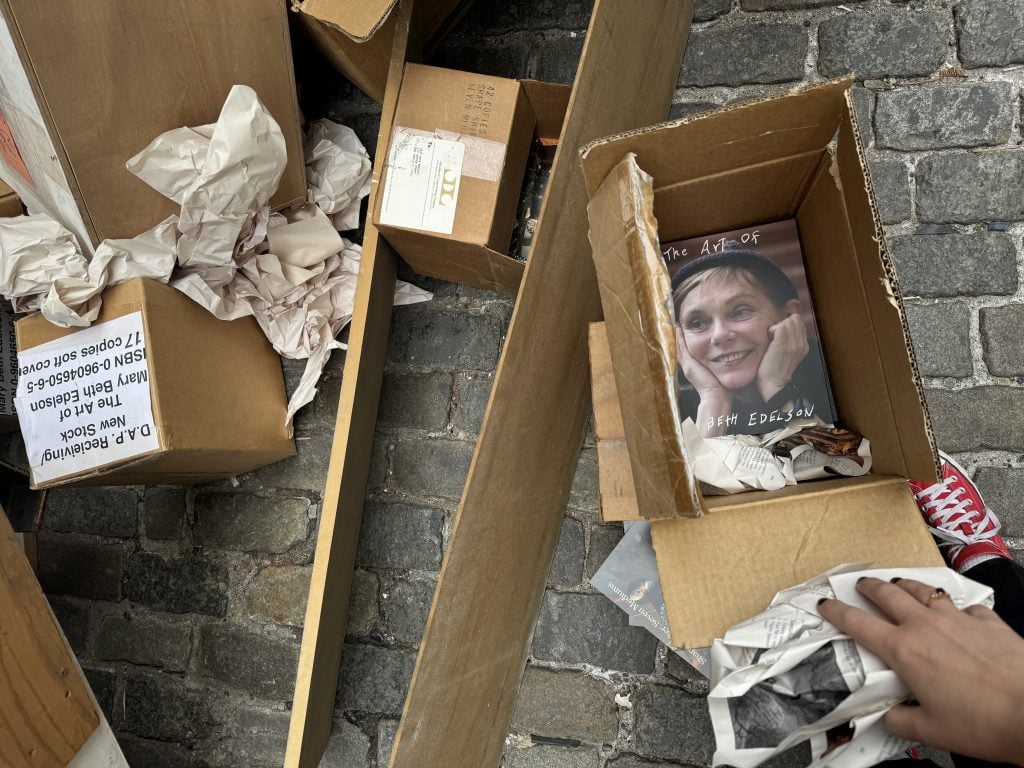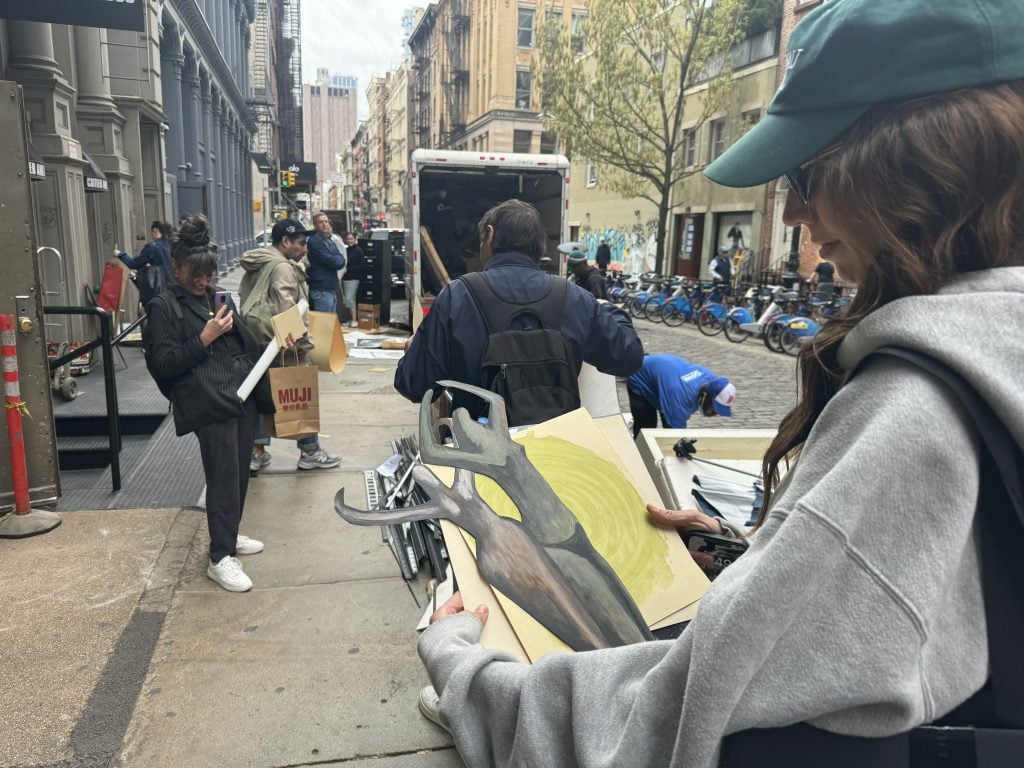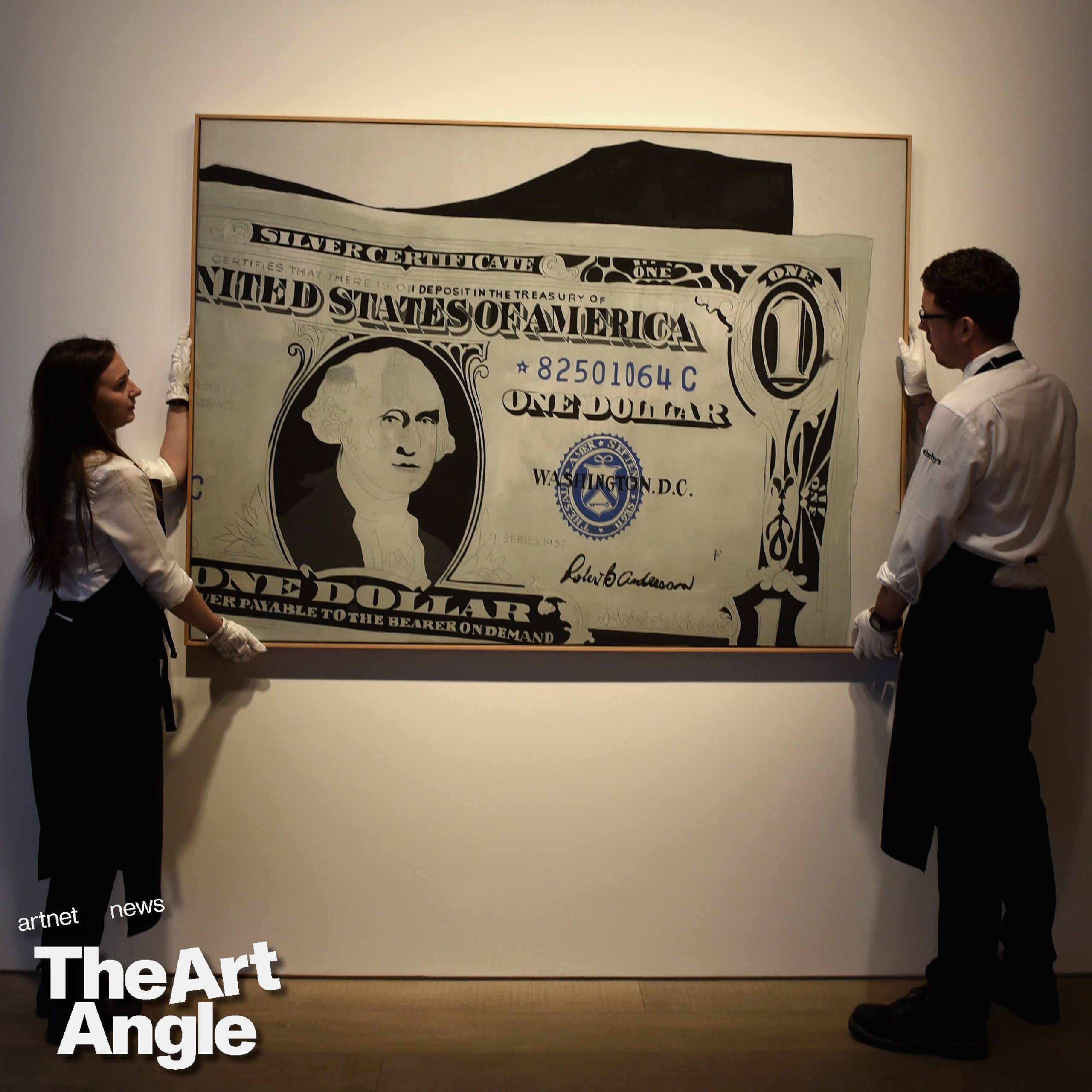Art
Controversial art dealer's daughter will return over 100 antiquities to Cambodia – CNN


The indictment, brought before a New York court in 2019, claimed the British collector was part of an organized looting network that faked records for items it had taken or illicitly excavated from archaeological sites like Angkor Wat. Considered one of the world’s foremost authorities on art from the Khmer Empire, which ruled between the 9th and 15th centuries, Latchford had served as “a conduit” for stolen treasures since the 1970s, according to court documents.
He died in Thailand in 2020, aged 88, before answering the charges. But now the late dealer’s daughter, Nawapan Kriangsak, has promised to return all of the Cambodian artifacts, that she inherited from her father. Consisting of at least 100 statues and carvings, the collection is considered of such cultural significance that the country’s national museum in Phnom Penh is being expanded to accommodate it.
Cambodia’s Minister of Culture and Fine Arts, Phoeurng Sackona, told CNN that news of the items’ return had produced a “magical feeling.”
“Our culture and our statues are not just wood and clay, they possess spirits, and they have senses,” she said in a video interview, via a translator. “The pieces themselves want to come back to their country.”
A bronze statue of a male deity dating back to the late 11th century. Credit: Matthew Hollow/Royal Government of Cambodia
Of the items pledged, 25 have already been returned, according to Bradley J. Gordon, a legal advisor to the Cambodian government who helped negotiate the deal. The rest will be sent in batches, he said, with a further five due to arrive in the coming weeks. While the government has announced that over 100 objects are being returned, Gordon said over the phone that the final number will be “much higher” when smaller items are included in the evolving inventory.
Sackona said that her department would continue to investigate how the items came to leave the country. She would not, however, comment on the charges brought against Latchford. Nor would 49-year-old Kriangsak, who in a statement to CNN said that, upon her father’s death last August, she “inherited a collection but also a conversation.”
“Over the last few years I became increasingly convinced that the best way to deal with this legacy would be to give all his Khmer art, irrespective of origin, to the people of Cambodia,” she said. “Many of the returned statues and other objects have impeccable provenance. However, I decided not to discriminate between those for which I know about the provenance and those that I don’t. It’s all going home.”


Cambodia’s government believes that this 10th-century statue, depicting the Hindu god Shiva and his first-born son Skanda, came from the remote Koh Ker temple complex. Credit: Matthew Hollow/Royal Government of Cambodia
Widespread looting
The murky market for Khmer antiques results from the social and political upheaval that ravaged Cambodia in the latter half of the 20th century. With invasions and civil conflict falling either side of a 1970s genocide carried out by former prime minister Pol Pot’s barbarous Khmer Rouge, protecting cultural heritage was rarely priority in the country.
Looters took full advantage of the instability. Statues and architectural elements were taken directly from temples and archaeological sites, often crossing the border to Thailand before finding their way onto the international art market.
Sotheby’s did not respond to CNN’s request for comment.


This bronze carving of a legendary Garuda bird would have adorned a ship. Credit: Matthew Hollow/Royal Government of Cambodia
Elsewhere, the Cleveland Museum of Art has three items — of both Cambodian and Thai origin — once owned by Latchford, though none were directly acquired from him. A spokesperson said the museum has a “strong, collaborative” relationship with Cambodia, and is set to borrow a number of Khmer artifacts from the country for an exhibition this autumn. The Denver Museum of Art, which holds six of Latchford’s objects, meanwhile said that it has recently opened discussions with Cambodian authorities. “The museum proactively contacted cultural officials in Cambodia regarding these pieces about a year ago,” a museum spokesperson said via email, “and our dialogue with Cambodia remains ongoing about their provenance.”


Cambodia’s late deputy Prime Minister Sok An shakes hands with Douglas Latchford during a function at the National Museum of Cambodia in Phnom Penh. Latchford repatriated a number of Khmer antiquities during the event. Credit: Tang Chhin Sothy/AFP/Getty Images
Despite growing suspicions about Latchford’s activities in the Western art world, he continued to enjoy more favorable standing in Cambodia. Having previously donated items to the national museum in Phnom Penh, he was awarded the Royal Order of Monisaraphon, the country’s equivalent of a knighthood, in 2008.
His daughter, Kriangsak, said that in addition to returning artifacts, she is also sharing her father’s records with Cambodian authorities. Investigating the collection’s provenance is now, she added, “the job of the archaeologists and researchers at the Ministry of Culture.”
Divided opinions
The politician said she hoped that the agreement will “send a message” to those still in possession of Cambodia’s cultural heritage. She described Kriangsak as a “role model” for other collectors and museums.
Not everyone familiar with the case is so sanguine about the late collector’s family, however. While welcoming the objects’ restitution, the CEO of the Association for Research into Crimes Against Art (ARCA), Lynda Albertson, suggested that Kriangsak is motivated by protecting her family’s reputation, saying in a phone interview: “If she was looking to right the wrongs of her father, she would have clearly stated: ‘I am doing this because (how he acquired the items) was wrong.”


A sandstone depiction of the deity Prajnaparamita is among the next items to arrive in Cambodia. Credit: Matthew Hollow/Royal Government of Cambodia
Albertson also said that other areas of Latchford’s collection — artifacts from India, in particular — should also be investigated, though Kriangsak declined to comment on the matter.
Latchford’s daughter did, however, claim that her father had indicated a willingness to return his Khmer items prior to his death. The dealer was alive when talks began three years ago, though, having been diagnosed with Parkinson’s and Alzheimer’s, his involvement was limited by his ailing health. By the time of the 2019 charges “his mind had gone,” Kriangsak added, saying that her father “was never aware of the indictment and never understood that there were specific charges, and he certainly couldn’t answer them or defend himself.
“Nobody could be expected to be consistent in the face of those health issues, and the future of his collection was a vexed issue,” she added, claiming that: “Many times my father told me and others that he would like major statues to return to Cambodia.”
Latchford’s true motivations and the nature of his acquisitions may never come to light. Nonetheless, ARCA’s Albertson suggested that the decision to return the treasures might yet lead to further restitution, with items handled by the late dealer still in collections around the world.
“As long as Latchford’s name comes up in the provenance (or) history of objects, it will make them toxic in terms of resale,” she added. “So, this might create a sense of ‘let’s give it back or let’s create some good press,’ or some feelings of goodwill between different collectors. But that remains to be seen.”
Pictured top: A 10th century statue of the deity Ardhanarishvara
Art
Art and Ephemera Once Owned by Pioneering Artist Mary Beth Edelson Discarded on the Street in SoHo – artnet News
This afternoon in Manhattan’s SoHo neighborhood, people walking along Mercer Street were surprised to find a trove of materials that once belonged to the late feminist artist Mary Beth Edelson, all free for the taking.
Outside of Edelson’s old studio at 110 Mercer Street, drawings, prints, and cut-out figures were sitting in cardboard boxes alongside posters from her exhibitions, monographs, and other ephemera. One box included cards that the artist’s children had given her for birthdays and mother’s days. Passersby competed with trash collectors who were loading the items into bags and throwing them into a U-Haul.
“It’s her last show,” joked her son, Nick Edelson, who had arranged for the junk guys to come and pick up what was on the street. He has been living in her former studio since the artist died in 2021 at the age of 88.
Naturally, neighbors speculated that he was clearing out his mother’s belongings in order to sell her old loft. “As you can see, we’re just clearing the basement” is all he would say.


Photo by Annie Armstrong.
Some in the crowd criticized the disposal of the material. Alessandra Pohlmann, an artist who works next door at the Judd Foundation, pulled out a drawing from the scraps that she plans to frame. “It’s deeply disrespectful,” she said. “This should not be happening.” A colleague from the foundation who was rifling through a nearby pile said, “We have to save them. If I had more space, I’d take more.”
Edelson’s estate, which is controlled by her son and represented by New York’s David Lewis Gallery, holds a significant portion of her artwork. “I’m shocked and surprised by the sudden discovery,” Lewis said over the phone. “The gallery has, of course, taken great care to preserve and champion Mary Beth’s legacy for nearly a decade now. We immediately sent a team up there to try to locate the work, but it was gone.”
Sources close to the family said that other artwork remains in storage. Museums such as the Guggenheim, Tate Modern, the Museum of Modern Art, the Brooklyn Museum, and the Whitney currently hold her work in their private collections. New York University’s Fales Library has her papers.
Edelson rose to prominence in the 1970s as one of the early voices in the feminist art movement. She is most known for her collaged works, which reimagine famed tableaux to narrate women’s history. For instance, her piece Some Living American Women Artists (1972) appropriates Leonardo da Vinci’s The Last Supper (1494–98) to include the faces of Faith Ringgold, Agnes Martin, Yoko Ono, and Alice Neel, and others as the apostles; Georgia O’Keeffe’s face covers that of Jesus.


A lucky passerby collecting a couple of figurative cut-outs by Mary Beth Edelson. Photo by Annie Armstrong.
In all, it took about 45 minutes for the pioneering artist’s material to be removed by the trash collectors and those lucky enough to hear about what was happening.
Dealer Jordan Barse, who runs Theta Gallery, biked by and took a poster from Edelson’s 1977 show at A.I.R. gallery, “Memorials to the 9,000,000 Women Burned as Witches in the Christian Era.” Artist Keely Angel picked up handwritten notes, and said, “They smell like mouse poop. I’m glad someone got these before they did,” gesturing to the men pushing papers into trash bags.
A neighbor told one person who picked up some cut-out pieces, “Those could be worth a fortune. Don’t put it on eBay! Look into her work, and you’ll be into it.”
Follow Artnet News on Facebook:
Want to stay ahead of the art world? Subscribe to our newsletter to get the breaking news, eye-opening interviews, and incisive critical takes that drive the conversation forward.
Art
Biggest Indigenous art collection – CTV News Barrie
[unable to retrieve full-text content]
Biggest Indigenous art collection CTV News Barrie





Source link
Art
Why Are Art Resale Prices Plummeting? – artnet News


Welcome to the Art Angle, a podcast from Artnet News that delves into the places where the art world meets the real world, bringing each week’s biggest story down to earth. Join us every week for an in-depth look at what matters most in museums, the art market, and much more, with input from our own writers and editors, as well as artists, curators, and other top experts in the field.
The art press is filled with headlines about trophy works trading for huge sums: $195 million for an Andy Warhol, $110 million for a Jean-Michel Basquiat, $91 million for a Jeff Koons. In the popular imagination, pricy art just keeps climbing in value—up, up, and up. The truth is more complicated, as those in the industry know. Tastes change, and demand shifts. The reputations of artists rise and fall, as do their prices. Reselling art for profit is often quite difficult—it’s the exception rather than the norm. This is “the art market’s dirty secret,” Artnet senior reporter Katya Kazakina wrote last month in her weekly Art Detective column.
In her recent columns, Katya has been reporting on that very thorny topic, which has grown even thornier amid what appears to be a severe market correction. As one collector told her: “There’s a bit of a carnage in the market at the moment. Many things are not selling at all or selling for a fraction of what they used to.”
For instance, a painting by Dan Colen that was purchased fresh from a gallery a decade ago for probably around $450,000 went for only about $15,000 at auction. And Colen is not the only once-hot figure floundering. As Katya wrote: “Right now, you can often find a painting, a drawing, or a sculpture at auction for a fraction of what it would cost at a gallery. Still, art dealers keep asking—and buyers keep paying—steep prices for new works.” In the parlance of the art world, primary prices are outstripping secondary ones.
Why is this happening? And why do seemingly sophisticated collectors continue to pay immense sums for art from galleries, knowing full well that they may never recoup their investment? This week, Katya joins Artnet Pro editor Andrew Russeth on the podcast to make sense of these questions—and to cover a whole lot more.
Follow Artnet News on Facebook:
Want to stay ahead of the art world? Subscribe to our newsletter to get the breaking news, eye-opening interviews, and incisive critical takes that drive the conversation forward.
-
Media14 hours ago
DJT Stock Rises. Trump Media CEO Alleges Potential Market Manipulation. – Barron's
-
Media16 hours ago
Trump Media alerts Nasdaq to potential market manipulation from 'naked' short selling of DJT stock – CNBC
-
Investment15 hours ago
Private equity gears up for potential National Football League investments – Financial Times
-



 Sports19 hours ago
Sports19 hours ago2024 Stanley Cup Playoffs 1st-round schedule – NHL.com
-



 Investment24 hours ago
Investment24 hours agoWant to Outperform 88% of Professional Fund Managers? Buy This 1 Investment and Hold It Forever. – The Motley Fool
-



 Health23 hours ago
Health23 hours agoToronto reports 2 more measles cases. Use our tool to check the spread in Canada – Toronto Star
-
Business15 hours ago
Gas prices see 'largest single-day jump since early 2022': En-Pro International – Yahoo Canada Finance
-
Real eState7 hours ago
Botched home sale costs Winnipeg man his right to sell real estate in Manitoba – CBC.ca



